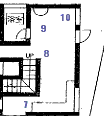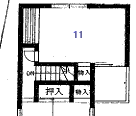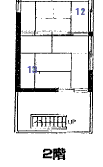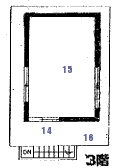
| Intro | Speech contest | Pizza delivery | Osechi foods | Gallery show | Marble house | Kamakura | Bonenkai | Bonenkai 2 | Emperor | Sapporo | Walking | Hanami | Visitors | Skiing | 7 Lucky gods | Visitor's survival guide | Kasuga |
marble house in bunkyo-ku
February 2000
 |
 |
 | |
 |
 |
 | |
[entry] [living/dining] [kitchen/bath] [bedroom] [office] [playharbour]
"Bunkyo-ku?" he repeated, incredulous.
"Yes, we've moved to Bunkyo-ku. Sendagi 1-chome."
Our Japanese friends all seem astonished that we've moved across town to Bunkyo-ku. But they won't tell me why.
Bunkyo-ku, a Tokyo ward located north of the Imperial Palace, has a mixed reputation. It is part of "shitamachi," the downtown, blue collar neighborhood. Two hundred years ago it was a rough and tumble place, or parts of it were.
Today it is home to nine universities and colleges, including University of Tokyo, one of the largest in the city. It adjoins Taito-ku where you'll find all of the capital's major museums. So while rough and tumble, Bunkyo's also academic and a little bit haughty. The name Bunkyo is a pun. Bunkyo means education when written one way, but our ku spells its name as Composition Capital.
Perhaps our friends are surprised because foreigners don't usually come to Bunkyo-ku. I have to admit that I havent seen many gaijin faces. There's virtually nothing in English and no international schools or fancy Western-style apartments which foreigners usually seek out.
But Sendagi, our new neighborhood, is perfect for me. We live on a busy street with buses roaring past and shopping all around. Three separate subway lines are within a six minute radius.
Down the street towards Sendagi station are a meat shop, a fish shop, a vegetable shop and a grocery. In the other direction I can buy rice, soaps, towels and flowers. There are bakeries near two of our subway stations and a half dozen liquor stores on the way home. Prices here are much lower than our old neighborhood--chicken breast is only 140 yen for 100 grams --that's about $7 a pound). In Himonya it was closer to $13/lb. So shopping is fun and economical.
We have a library within a five minute walk (though they don't seem to have many English books), temples and shrines on every side, and a botanical garden 15 minutes away. A short bike ride brings us to a 300 year old Japanese garden. Tiny mom and pop shops of every variety line side streets. There are even some good restaurants.
What more could I need? I can't imagine.
It's cozy here. Everything is just a little bit older and more old-fashioned than our previous upscale neighborhood. Including our house. When Inoue-san, our youthful realtor, showed us the floorplans he looked concerned.
"Chotto furui desu ne...(It's a little bit old.)" he said, indicating the construction date on the printout.
I converted the date (Showa 57) and subtracted. The house is 19 years old. The house we own in Pittsburgh is about 70 years old. 19 doesn't seem that old, really.
But the Japanese love new things and housing is no exception. Old buildings are pulled down and new ones constructed in their place. When we signed the lease we were warned that we'll only be allowed two renewals, which means a total of six years, and then we will have to move. Presumably, the owners plan to build something new here.
When Inoue-san showed us the floorplans, we made an appointment to see the inside. Unfortunately, our appointment was a week off, so we walked over to look at the outside of the house.
The house is quirky, charming and ugly. I loved it the moment I saw it. In front of the grimy cream-colored concrete building there is parking for two cars. Since we haven't even one car, I started to make plans to fence the front in and make it into a nice patio area.
We sneaked around the side of the house to peek in the windows. There's a tiny side yard--a patch of dirt, really, with a glass door leading into the living room.
In the dirt Tod spotted a marble. Then another one. That decided it for me. No matter what the inside looked like, we'd be living here.
For most of our married life we have found marbles in unexpected places--along streets where we've lived and worked, in the backyard of our house. They appear like little spherical omens.
So we nicknamed this potential new home the Marble House. I kept my fingers crossed and spent the week looking at the floor plans and imagining how we'd arrange things inside.
When we saw the inside, Tod was noncommittal, maybe a little bit reluctant. I was ecstatic. The inside is just as charming and ugly as the outside.
It's a two story house with an extra room on the roof. On the first floor, you enter a terra-cotta tiled foyer and step up (after removing your shoes, of course) into a worn, parquet-floored entryway. A frosty textured glass door straight ahead leads to the living room.
The living room has white walls, light wood flooring and windows on opposite sides of the room. A small tatami room at the back of the house is the dining room. Its windows are covered with paper screens that filter the light from outside and hide the neighbors' air conditioners and laundry poles.
There are two more tatami rooms upstairs, along with a wood-floored room and two small balconies. The balcony in the back has rusty metal stairs leading up to what is marked on the floor plans as a "pu re ha bu." I read that as 'play harbor" but Tod's coworkers teased me--it's a really supposed to be pronounced "prefab." Still, it's the Play Harbor to me--a big room with no heat and lots of storage shelves. Looks perfect for an art studio.
The kitchen on the first floor near the front of the house is definitely 1981. Or maybe earlier. The floor is cork patterned vinyl. The counters are stainless steel. Cabinetry is off-white formica with dark wood trim and metal handles. The tile backsplash is various shades of forest and olive. There's no fridge and no stove or oven.
In typical Japanese fashion, the toilet is tucked away in a closet in the front hall. We discovered later that it used to be a squat toilet but has been retrofitted with a seat and bidet. It's very pink and a little bit smelly.
The rest of the bathing fixtures are divided from the kitchen by a big wood-framed archway. There's no door. The deep stainless steel bath inhabits a white tiled room. The vanity cabinet and sink sit nearby, open to views from the kitchen. There's a hookup for a washing machine.
"Obviously," I thought as I took it all in, "there will need to be a little bit of creative interior decorating to make this work. But that's not outside my abilities." I considered a folding screen to shield the bath from the kitchen. Tod was not convinced; he noticed there's no heat.
Still, I decided in my bossy way that this is the place. We told Inoue-san that we'd like to see about having heater units installed. He talks to the landlord; partly to discuss the heat issue and partly to make sure that it's OK that gaijin rent the place. Landlords don't have to rent to anyone undesirable--including us. Fortunately, we are not a problem. Neither is the heat.
Two weeks later the lease was signed in a grand meeting of realtors, landlords, house agents, Tod & his employer. The entire lease was read aloud. Some parts were translated so Tod understood. Some were not. Huge quantities of money were passed over. Two months' rent for deposit. Two months' rent as a non-refundable gift to the landlord; a month's rent in agent fees. And of course, the first month's rent. In exchange, we received the keys.
That night, keys in hand, we went to measure the kitchen. We need to get a fridge and a "gas table" for the kitchen. And there are some furniture things we think we'll want, too.
We were standing in the kitchen, debating the merits of appliances, when we heard a noise that sounded like someone hammering a corrugated metal roof.
"What's that?!" we said simultaneously as the sound grew louder.
Fumbling with the locks, we opened the side door in time to see a procession of Buddhist priests, garbed in wide wicker hats, short black robes and rope sandals, walking past the house, beating on skin drums.
"Do you think we'll get that every night?" we wondered. We stuck our heads back inside.
Our measurements were useful when we arrived at the bewildering appliance stores. The measurements were, for the most part, the only part of the advertising description we could understand! We selected our refrigerator based on size and the location of the ice section.
We shopped for price, too, and selected something in the middle range for all of our appliances. The fridge cost about $1,200. The most expensive fridge, plain but with an enamel-coated exterior instead of plastic, was about $3,200.
It was strange to buy a stove. Japanese kitchens generally don't have ovens. The kitchen has a special counter, a little lower than the others, fit for a gas table--an oversized camp stove. We bought a gas table with three burners, but most have only two. For most Japanese homes, two burners are adequate. There's very little home entertaining in Tokyo, so no need to have elaborate meals or the equipment to prepare them. However, I love to host dinner parties, so I decided to indulge in an extra burner.
Our last appliance purchase was a washing machine and dryer. Our previous apartment had a beautiful Swiss washer/dryer. Front-loading, stacking and very efficient. A joy to use. And, we discovered in a flurry of faxes, about $6,000 for the pair! Needless to say, we did not buy that brand.
Instead we opted for a Mitsubishi washer and dryer at one-fifth the price. The washer weighs the load and adjusts water and wash time accordingly. It washes really quickly but only in cold water (unless you pump in your leftover bath water, pump attachment included).
Dryers have not totally caught on in Japan. Most people still hang their wash out. But I'm an American, used to my American comforts, and would not go dryerless. But I can see why most Japanese don't bother with dryers. The dryer holds significantly less than the washer and takes about 3 hours to dry a full load. I'm getting used to the new pace of laundry now...
And the pace of life in Bunkyo-ku. With our move we've created a better hybrid life between Japan and America. Maybe that's why our friends are surprised.